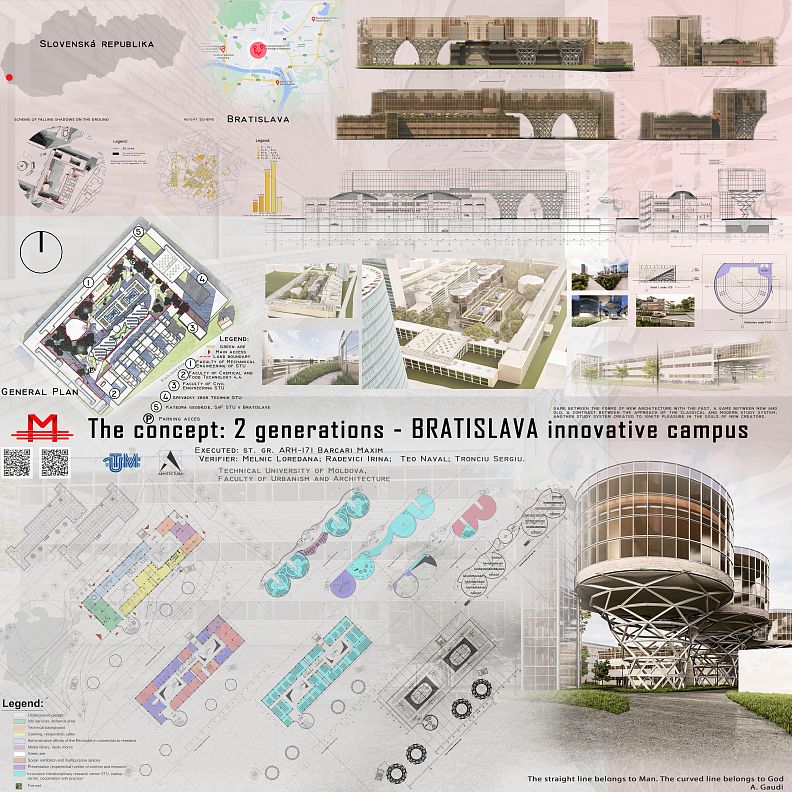2 generations

Project idea
The concept is a game between the forms of new architecture with the past, a game between new and old, a contrast between the approach of the classical and modern study system, another study system created to ignite pleasure in the souls of new creators.
Project description
The “2 generations” concept is a multifunctional complex for “STU”, BRATISLAVA, meant to be a real research center, a laboratory, an asylum for young creators united in order to change the world, a complex equipped with all the equipment for a research .
Volumetric solving arises from the philosophy of circular spaces, which in turn arise from the form of propagation of sound waves. The concept assumes that in such spaces all students are in conditions of maximum equality and the space of information propagation is comparable for all students, compared to the rectangular shapes where the corners are with the weakest perception of information.
Also here, in these circular shapes, there is a start-up office for experimenting and creating ambitious young people. The office is equipped with the latest technology with a separate server from the other university (the area of the center is 333 square meters). Next to block there is also a library in circular shapes. Where possible, the layout of the seats was kept, circular, around an arentie center (middle of the sheet), and the sheet itself is oriented at the optimal angle of the sun's rays. On the 2nd floor of the rectangular block we find a medium capacity audition where the monitor was used to repeat the image on the board, it is created for more efficient acquisition of information.
For the support of the second block, as a resistance structure is proposed the massive metal structure, similar to "Le Tour Eiffel", it creates a visual freedom at ground level and frees up space for people. It is assumed the presence of 3 terraces, of which 2 are circulable and 1 non-circulable with it through the vertical ladder for technical service. This terrace assumes the presence of photovoltaic panels facing south with the optimal inclination, 30 degrees.
Floors 1 and 2 are equipped with special lockers for students where they can leave their winter clothes or other personal belongings.
On the ground floor there is an entrance area with an information desk and interactive panels to find information when needed. The information office in addition to all this involves the presence of 3 employees of the information office. Near the information office there was a commercial area with printing and copying machines, but also a commercial area, office. Next to the commercial area is the security area and the workers' spaces (Separate spaces for workers can be found in the commercial area, rectory and kitchen). In the administration includes an archive near the anteroom. Kitchen of 500 square meters (250 dining area), is not supposed to spend all the processes analogous to a restaurant, but rather a preparation area.
The atrium is designed to escape from the classic corridors and create the feeling of freedom inside and its lighting is provided by a glass "pyramid" attached to metal profiles.
The parking lot creates on the ground a total area destined for vegetation, creating the atmosphere of nature, untouched by man, in contrast to the architecture of existence. Basement 1 has the connection to the existing basement which in a way replaces the current entries. The shape of the basement is dictated by the boundaries of the site. On the ground floor there are parking lots for bicycles and in the basement we have places for 150 cars (per floor), among which 8 near the elevator are for people with disabilities.
Technical information
. The "wienerberger - Porotherm 38 Thermo" brick was chosen as the material for both interior and exterior walls. The exterior walls use a “wienerberger - Agora Wijnrood” finish, and 12cm extruded polystyrene thermal insulation. with poles placed from scratch. The reason for the radical change of the construction is the inflexibility of the current system, existing at the time and the desire to create an atrium with natural lighting "from above" and create another feeling on the inside, a visual freedom inside contrasts with systems with corridors. Inside there are 3 "KLEEMANN" elevators, panoramic elevator with a capacity of 450 kg, 2 of them on the ground floor are inside a green planter separated by railings. The psychological comfort of man inside the building is a basic goal in architecture. The roofs all in the project are used to the maximum with a slope of 1.5%
The access to the basement is made through 2 ramps creating 2 main accesses on the site, the inclination of these ramps does not exceed 10 degrees, the width of the ramps is 7.5 meters which allows us to evacuate people in accessible time.
For firefighting reasons for the bionic block, 2 stairs are proposed, which are not intended for permanent circulation but only have a smoke-protected fire escape staircase. The exterior of these stairs is made of glass placed on a metal profile, it is created to make the image as easy as possible at ground level.






